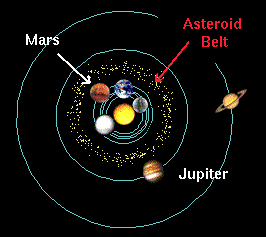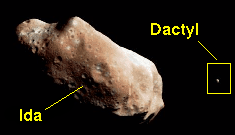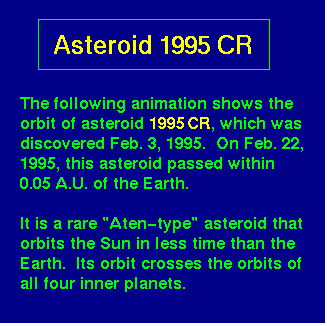|
 Asteroids are rocky and metallic objects too small to be
considered planets. They are sometimes called minor planets.
They range in size from Ceres, with a diameter of about 1000 km, down to a few centimeters
or less. The ajacent image shows the asteroid Gaspra, as photographed by the Galileo space probe
(Ref).
The name asteroids, meaning "star-like", derives from the fact that, compared
with comets, they are star-like in appearance because since they are rocky they
do not emit the gases and dust that give comets their fuzzy appearance. Asteroids are rocky and metallic objects too small to be
considered planets. They are sometimes called minor planets.
They range in size from Ceres, with a diameter of about 1000 km, down to a few centimeters
or less. The ajacent image shows the asteroid Gaspra, as photographed by the Galileo space probe
(Ref).
The name asteroids, meaning "star-like", derives from the fact that, compared
with comets, they are star-like in appearance because since they are rocky they
do not emit the gases and dust that give comets their fuzzy appearance.
Asteroids on a collision course with Earth are called meteoroids.
If this meteoroid burns up because of frictional heating when it strikes our
atmosphere, we term it a meteor (colloquially, a "shooting star").
If the meteoroid doesn't burn up completely and strikes the Earth we call it a meteorite.
We shall discuss, meteoroids, meteors, and meteorites in the next section.
General Properties
 Asteroids represent material left over from the formation of the solar system.
Although is has been suggested that asteroids are the
remains of a planet that was destroyed in a massive collision, it is more likely that they represent material
that never coalesced into a planet. If the estimated total mass of all asteroids was gathered into a
single object, the object would be less than half the diameter of the Moon
(Ref).
Asteroids represent material left over from the formation of the solar system.
Although is has been suggested that asteroids are the
remains of a planet that was destroyed in a massive collision, it is more likely that they represent material
that never coalesced into a planet. If the estimated total mass of all asteroids was gathered into a
single object, the object would be less than half the diameter of the Moon
(Ref).
The Asteroid Belt
The highest concentration of asteroids is in a region lying between the orbits of Mars and Jupiter called the
asteroid belt that is illustrated schematically in the adjacent figure.
Here is a more realistic
distribution of semimajor axes
for the minor planets. Some 7000 asteroids have been identified so far.
Most, but not all, have average orbital radii lying in the region of the
asteroid belt. It is likely that the origin of the asteroid belt lies in the
gravitational perturbation of Jupiter, which kept these planetisimals from coelescing into larger bodies.
Kirkwood Gaps
Asteroid orbit distributions
show evidence for Kirkwood Gaps, which are certain orbital radii within the asteroid
belt for which there are few asteroids. These gaps are associated with orbital radii that lead to orbital
periods that are ratios of integer multiples of Jupiter's orbital radius.
They result from resonance interactions with Jupiter that tend to eject asteroids from such orbits.
Galileo Flys by Gaspra
 The adjacent figure shows the asteroid Gaspra, which was investigated by the
Galileo spacecraft
(Ref).
Gaspra is irregular, with dimensions about 19 x 12 x 11 kilometers.
This image was taken 10 minutes before closest approach on October 29, 1991, at a range of 5,300 kilometers.
The adjacent figure shows the asteroid Gaspra, which was investigated by the
Galileo spacecraft
(Ref).
Gaspra is irregular, with dimensions about 19 x 12 x 11 kilometers.
This image was taken 10 minutes before closest approach on October 29, 1991, at a range of 5,300 kilometers.
The surface gravitational force is so weak on this small body that the
gravitational escape speed is only 10 meters per second---comparable to the
speed of a fast sprinter. In this gravitational field, a 200 pound man would weigh only 0.1 pounds!
Gaspra has a high concentration of small craters compared to
larger ones relative to other small objects in the Solar System like the moons
of Mars (which may be captured asteroids).
This is consistent with the theory that Gaspra originated comparatively recently from the
collisional breakup of a larger body perhaps 10 times the present size of Gaspra
(Ref).
The Asteroid Ida and its Moon Dactyl
 The Galileo spacecraft found a surprise when it flew by the asteroid Ida: Ida has a
tiny moon, which has been named Dactyl!
The adjacent color-enhanced picture shows both asteroid 243 Ida and Dactyl
at about 14 minutes before closest approach of Galileo on August 28, 1993, at a range of 10,500kilometers.
The Galileo spacecraft found a surprise when it flew by the asteroid Ida: Ida has a
tiny moon, which has been named Dactyl!
The adjacent color-enhanced picture shows both asteroid 243 Ida and Dactyl
at about 14 minutes before closest approach of Galileo on August 28, 1993, at a range of 10,500kilometers.
Ida (left) is about 56 kilometers long and Dactyl (right) is about 1.5 kilometers across in this view.
Dactyl is actually in the foreground, about 80 kilometers closer to the spacecraft than Ida is.
Dactyl is not identical in spectral properties to any area of Ida in view here, though its overall
similarity in reflectance and general spectral type suggests that it is made of basically the same rock types
(Ref).
The Spin of Asteroid Toutatis
By making a series of observations, it is possible to study the rotation of some asteroids. Most have
simple rotations around a fixed axis, with periods typically between one hour and one day. For example, here is a
movie (83 kB MPEG) made by the Hubble Space Telescope of the
asteroid Vesta in rotation (Ref).
However, the asteroid 4179 Toutatis (which crosses Earth's orbit)
has been found through radio telescope observations to have an
irregular shape and a complex tumbling rotation---both thought to
arise from a history of violent collisions.
Here is a short animation (47 kB MPEG) of the spin of Toutatis;
here is a longer animation (288 kB MPEG).
It is believed that violent collisions are common for asteroids, and that many
asteroids have in their past experienced complex rotations like Toutatis as a
consequence of such collisions.
However, internal friction has caused them to dampen into simple rotation in relatively brief
amounts of time; thus, most asteroids are observed to have simple rotations.
But Toutatis rotates so slowly that this dampening process would take much
longer than the age of the Solar System. Thus, the rotation of Toutatis may be
a relic of the collisional evolution of an asteroid
(Ref).
Earth crossing Asteroids
Certain groups of asteroids have elliptical orbits that cross the orbit of the
Earth and other inner planets. Thus, these asteroids can come very close to
the Earth. This provides a rationale to study such asteroids beyond the merely scientific one.
The Earth-Crossing Asteroid 1995 CR
 The adjacent animation illustrates the orbit of asteroid 1995 CR,
which was only discovered in 1995. The animation covers the two years---February 3, 1994 through February 3, 1996---at
approximately 1 month intervals, except near the time of discovery (February 3,
1995) where the interval is about 10 days.
The adjacent animation illustrates the orbit of asteroid 1995 CR,
which was only discovered in 1995. The animation covers the two years---February 3, 1994 through February 3, 1996---at
approximately 1 month intervals, except near the time of discovery (February 3,
1995) where the interval is about 10 days.
This asteroid is of a relatively rare type with an orbital period much faster
than that of the Earth. Notice that its orbit crosses the orbit of all 4 of
the inner planets (though not obvious here, the orbit is almost in the plane of
the ecliptic). On February 22, 1995 (2 1/2 weeks after discovery), this
asteroid passed within 7.5 million km of the Earth---a distance only 20 times
that of the distance to the Moon (note that in the animation the sizes of the
planetary disks and of the asteroid are greatly exaggerated).
Notice how rapidly the asteroid moves on the inner part of its orbit (Kepler's
2nd Law). It covers approximate half of the distance around its orbit in only
about 2 months when it is near the Sun!
Here is the
Present Position
of the asteroid 1995 CR.
Other Earth-Crossing Asteroids
There are a many other known asteroids that cross Earth's orbit (about 300 have been indentified
at present). Here is a
general information source on Near Earth Objects (NEOs) and here is a
listing
of asteroids that come near the Earth and their orbital elements (the orbital elements allow
their orbit to be plotted with the
Solar System Live software). Here is an
information leaflet from the Royal Greenwich Observatory
summarizing close approaches and comets and asteroids to the Earth in recent years.
Here are some
predicted close
approaches of asteroids from now until the year 2020. The good news is
that none of these will strike the Earth. The bad news is that we probably
have discovered only a fraction of the total number of Earth-crossing
asteroids, so there are many for which we do not know the orbit. One estimate is that
the entire population of Earth-crossing asteroids includes some 1500
larger than one kilometer and 135,000 larger than 100 meters in diameter.
One such Earth-crossing asteroid is Toutatis, which was discussed in the preceding section.
Its eccentric, four-year orbit extends from just inside the
Earth's orbit to the main asteroid belt, and the plane of
Toutatis' orbit lies closer to the plane of the Earth's orbit than any other Earth-crossing
asteroid presently known.
On September 29, 2004, Toutatis will pass by the Earth at a distance of only
4 times the distance to the Moon---the closest approach to Earth of
any known asteroid or comet between now and 2060. The
asteroid's frequent close approaches to Earth render its orbit chaotic, so that
its trajectory more than several centuries into the future cannot be predicted accurately
(Ref).
Orbitant Asteroids
| Asteroid |
Year of
discovery |
Orbitant period
(year) |
Diameter
(Km) |
Mass
(10^12 tons) |
Nearest
approch
to the Earth
(10^12 Km) |
| Albert |
1911 |
4 |
4.8 |
300 |
32 |
| Eros |
1898 |
1.76 |
24.1 |
15000 |
22.5 |
| Amor |
1932 |
2.67 |
16 |
12000 |
16 |
| Apollo |
1932 |
1.81 |
3.2 |
100 |
11.2 |
| Icarus |
1949 |
1.12 |
1.6 |
12 |
6.4 |
| Adonis |
1936 |
2.76 |
1.6 |
12 |
2.4 |
| Hermes |
1937 |
1.47 |
1.6 |
12 |
.32 |
| 
